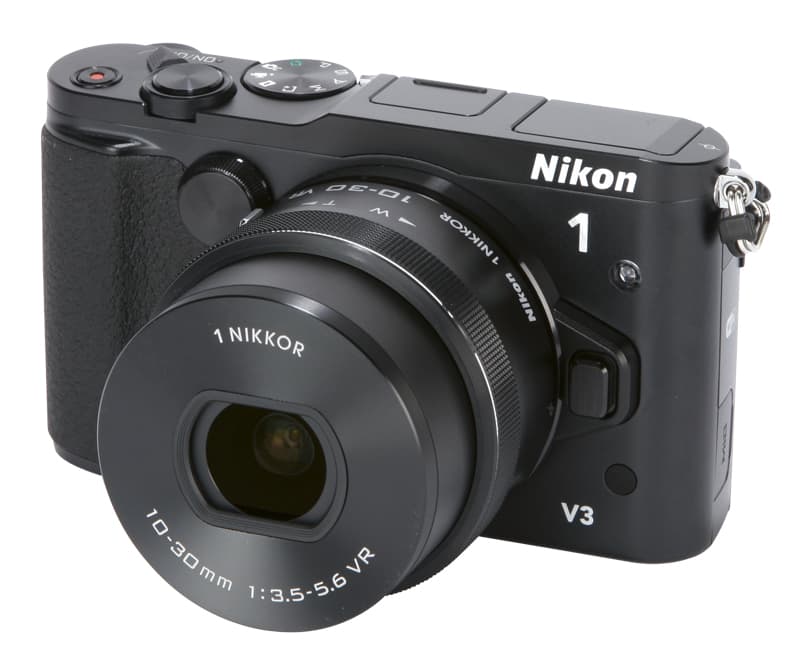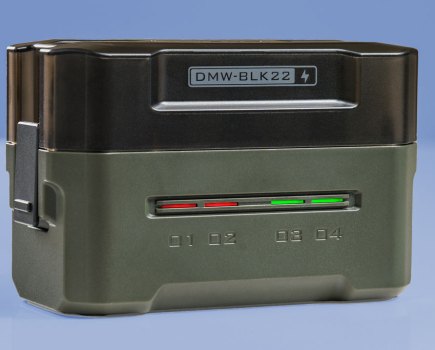Nikon 1 V3 at a glance:
- 18.4-million-pixel, 1in-sized CMOS sensor
- 1.04-million-dot 3in vari-angle touchscreen
- 60fps burst shooting
- ISO 160-12,800
- Street price £799 with 10-30mm f/3.5-5.6 PD-Zoom lens
Nikon 1 V3 review – Introduction
Nikon’s advanced offering from its system camera range hasn’t really hit the mark. The V1 didn’t offer the level of control expected of an enthusiast camera, and while the V2 addressed some of these issues, it was far from perfect. The question is, then, is it third time lucky for Nikon with the Nikon 1 V3?
Nikon 1 V3 review – Features
Nikon’s 1 system is based around a 1in (13.2×8.8mm) sensor, with the V3 featuring a new chip with a 18.4-million-pixel resolution. The Nikon 1 V3’s sensor does away with an optical-low pass filter for greater resolving power, and while moiré patterning is a concern with this absent, we’ve seen in the past that Nikon has some clever processing algorithms to combat this.
The ISO range has been improved as well, with an effective range from 160-12,800, while the V3 also utilises Nikon’s Expeed 4A image engine that incorporates two processors for enhanced performance, allowing the V3 to shoot at up to 60fps at full resolution.
The Nikon 1 V3 is bundled with a new 10-30mm f/3.5-5.6 PD-Zoom lens that has a compact design with a 35mm focal-length equivalent of 27-81mm and equipped with a power-drive zoom designed to deliver a smooth transition through the zoom range.
Nikon 1 V3 review – Build and handling
After the fairly minimalist design of the original V1 and the rather awkward-looking V2, the V3 is easily the most conventional looking of the trio, taking on an appearance not to dissimilar to an enthusiast compact.
The absence of the deep and comfortable grip on the V2 means the V3 is not quite as satisfying to hold, but you can still get a reasonable purchase on it and its omission means that its overall footprint has been significantly reduced. This results in a relatively slim and compact body that delivers a sturdy feel, thanks to the use of magnesium alloy, aluminium and a quality rubber grip. If you desire something more substantial to hold on to, then the GR-N1010 attachable grip (£129) offers just that, while also incorporating an additional shutter-release button, another control dial and an additional function button.
One of the complaints levelled at the V1 and the V2 was that they both lacked a decent amount of body-mounted controls, with many settings menu-driven. Things are better with the V3, as it incorporates three control dials as well as two customisable function buttons. This makes operation much quicker, but the V3 is still not as satisfying as it could be, as the buttons feel fiddly to use and the camera is not quite as intuitive as I’d like. For example, when accessing the V3’s quick menu, the scroll wheel/four-point control dial is used to navigate between settings, but it can’t be used to adjust settings. Instead, the thumb-control dial has to be used to adjust this, while none of the three control dials can control exposure compensation. However, the menu is simple and uncluttered, making it easy to navigate, while the settings are comprehensive.
One final point worth mentioning is the fact that the Nikon 1 V3 now accepts MicroSD cards and not the more readily available SD format. There appears to be enough space to accommodate an SD card slot and rival manufacturers have achieved this with even smaller bodies, so it seems a curious decision for Nikon to make.
Nikon 1 V3 review – Metering and dynamic range
Metering
The Nikon 1 V3 features the usual trio of metering modes found on Nikon cameras, with matrix (multi-zone), centreweighted and spot-metering modes, while there are no nasty surprises in use. Behaving in a similar way to many Nikon DSLRs, the V3’s matrix metering delivers pleasing results, exposing predominantly for midtones and shadows. As such, you may find you have to dial in a -0.3-0.7EV stops of exposure compensation to avoid blown highlights in the sky, but this shouldn’t be a concern.
Dynamic range
The dynamic range offered is solid if unremarkable, and delivers a very similar performance to its V2 predecessor. Shadow detail can be recovered in post-processing, although noise can be an issue if pushed too heavily here. At the other end of the spectrum, highlights clip a little earlier than perhaps we would like.
Nikon 1 V3 review – Autofocus

Image: The supplied 10-30mm f/3.5-5.6 PD-Zoom lens offers a moderate focal range for general shooting
The V2’s AF performance was very snappy, and with the V3 Nikon hopes to improve on this. As with the V1 and V2, the V3 uses a hybrid AF system, but it has been refined and improved over its predecessors, featuring 171 contrast-detection areas, compared to 135 on the V2, while the phase-detection points have also been increased to 105 compared to 73. As with Nikon’s range of DSLRs, there’s a choice of either auto-select AF (AF-A), single AF (AF-S), continuous AF (AF-C) and manual, while there’s the option of auto-area, single-point and subject tracking AF-area modes.
AF speeds are very quick, acquiring focus almost instantly and even performing well in low light, although speed does suffer slightly. Continuous speed is also very impressive, and thanks to the powerful Expeed 4A image processor, the V3 is capable of maintaining continuous focusing at an incredible burst shooting speed of 20fps.
It’s worth noting, however, that with the new 10-30mm PD-Zoom lens comes the relatively audible AF noise, with the odd whirr and buzz as focus is acquired. While this is something that is perhaps not so much of an issue for still photography, it will be picked up by the Nikon 1 V3’s built-in microphone during video capture.
Nikon 1 V3 review – Noise, resolution and sensitivity

Image: The 18.4-million-pixel sensor offers an acceptable amount of detail, although it is not as strong as its rivals
The 18.4-million-pixel sensor performs well but not amazingly when it comes to resolution, delivering a reading of 24 on our resolution chart from a raw file, although this is no better than the files from the V2. JPEG images look pretty good straight out of the camera, while raw files – as expected – benefit from slight tweaks to contrast, clarity and sharpening to pull the best level of detail from them.
Despite colour and luminance noise being evident in the shadows at ISO 200, the V3 does a pretty good balancing act of delivering raw files with decent levels of detail with relatively well-controlled image noise at higher sensitivities. Files display quite a fine level of luminance noise even at ISO 3200, but that said, it’s still not a match for a larger sensor.
JPEG files at higher sensitivities display a slightly softer quality due to the noise control applied, with reduce levels of luminance noise apparent.

These images show 72ppi (100% on a computer screen) sections of images of a resolution chart, captured using the 10-30mm f/3.5-5/6 PD-Zoom lens. We show the section of the resolution chart where the camera starts to fail to reproduce the lines separately. The higher the number visible in these images, the better the camera’s detail resolution at the specified sensitivity setting.
Nikon 1 V3 review – White balance and colour

Image: The V3’s auto white balance worked well in most scenes, while colours produced were generally good
The auto white balance on the Nikon 1 V3 is generally reliable. It works well in most scenes, although it did tend to produce the occasional slightly cool image. Accompanying the auto white balance is a preset manual setting and a modest collection of six presets, although each of these can be adjusted if you want to fine-tune the look of your images for a slightly warmer or cooler result.
The V3 produced pleasing colours, although they were perhaps a touch muted on the default settings. This can be easily adjusted when editing raw files, while the V3 has an additional five image styles within the picture control menu. These can be adjusted individually, with sharpening, contrast, brightness, saturation and hue being able to be controlled and saved to the camera’s memory.
Nikon 1 V3 review – Viewfinder, LCD and video
The V3 does away with the built-in EVF seen on both the V1 and V2. While it could be argued that the inclusion of an EVF would have compromised the design and size of the V3, it’s a shame that it has not been included. This will perhaps be a bit of a turn-off for quite a few potential users, so to counteract this Nikon offers an optional DF-N1000 2,359,000-dot EVF (costing £249) that slots onto the accessory port on top of the V3 body. This will make composition much more satisfying and will be an essential piece of kit for those who have embraced the 2.7x crop factor of previous generations for wildlife and action photography via the FT1 F-mount adapter.
It’s worth noting that the accessory port doubles as the camera’s proprietary accessory port, so aside from the built-in flash, an additional flash can be attached (there are two in the range) or microphone should you not want to use the EVF.
For those relying solely on the rear display, the V3 sports a 3in touchscreen that has a 1.04-million-dot resolution, with the screen offering a 170° movement upwards and 87° downwards for awkward shooting angles. The display is responsive and shooting info clearly displayed (so long as you’re not shooting in the midday sun), while there’s a clever virtual horizon that features a graphical display overlaid over the image the camera’s roll and pitch.
The video feature on the V3 is impressive, offering capture at 50/60fps at full HD 1080p resolution, while for breathtaking slow-motion shots, the V3 can record at 120fps in HD 720p. There’s also a new Movie e-VR image stabilisation system to subtly crop round the edges of the frame for a more pleasing result.
Nikon 1 V3 review – Our verdict
There’s no denying that some aspects of the Nikon 1 V3 are impressive, particularly the super-fast AF and burst shooting speeds. That said, the V3 still seems quite a confused model when everything’s taken into account. With numerous auto controls and clunky handling characteristics, it’s far from the perfect tool for enthusiast photographers looking for a smaller alternative to their DSLR.
The sensor is also a little underwhelming, not offering a big step forward over the 14.2-million-pixel sensor used by the V2. Once you’ve factored in the rather steep asking price (even without the EVF and viewfinder), the V3 really does struggle to make a case for itself. Those looking for a compact system camera would be better off served by the likes of the Fujifilm X-E2 or Panasonic Lumix DMC-GX7, while those who want a pocketable camera should look no further than the Sony Cyber-shot DSC-RX100 II. Not only does the RX100 II feature a better 20.2-million-pixel, 1in sensor, but it also offers a broader and faster zoom lens, handling that’s more refined, a body size that slips easily into a pocket all at a more reasonable price.









